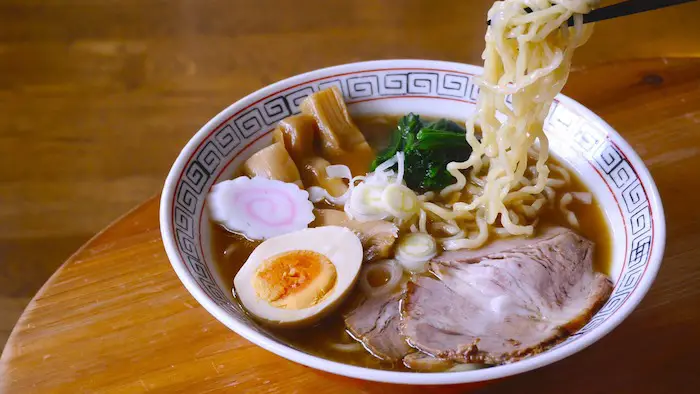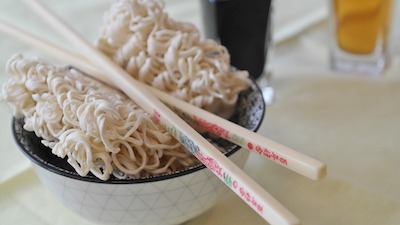We are reader supported. When you purchase through links on our site, we may earn an affiliate commission. Also, as an Amazon affiliate, we earn from qualifying purchases.

A packet of instant noodles containing those yellowish curls is a child’s first love, a college kid’s best friend, a busy employee’s quick hunger fix, and an object of nostalgia for many of us. Nearly all of us have eaten them in a myriad of ways and have many memories associated with this quick and filling dish.
Today’s question is: can you eat ramen raw?
I would say “yes,” and there’s no harm in doing that, although our parents, teachers, and several other people have told us not to. You can safely eat instant ramen noodles without worrying about any dire consequences.
Instant noodles are the dehydrated form of Japanese ramen, and these come with a wide choice of ingredients in the seasoning mixes to lend a more complex flavor to the dish. Rather than fully prepare them, many people just prefer to crush the instant noodles or keep them as they are, sprinkle the seasoning over them, and eat them as a quick snack.
Traditional Japanese ramen is made of wheat flour, water, salt, and kansui, which is a type of alkaline solution. Once the dough is made, it is left for some time to rise and then rolled into sheets and cut into fine strips. The chef boils these strips until they are soft and then adds them to a broth containing vegetables and meat.
Although traditional Japanese ramen is the proper way to prepare this food, a quick Google search will show you that innumerable people around the world love eating instant noodles raw out of the packet. Kids especially find it alluring to munch on that dry, brittle cake more than soft, mushy noodles. Almost every ramen lover has done it at least once and loved it, too.
However, I would like to add a word of caution here. Although raw ramen is a delicious and filling food for lazy buns, and there are no real health complications directly associated with it, overdoing it may not be a good idea. Just like a bag of chips, just make sure that you don’t eat ramen dry like this too often, and you should be fine.
Contents
Raw Ramen: Cooked Or Uncooked
Raw ramen is one of the most delicious snacks that people love to eat even though they are repeatedly told not to, along with being given various health warnings about doing so. However, the reasoning behind not eating these because they are uncooked turns out to be empty because the instant noodles are actually cooked and then dehydrated before they are packed.
So, if you are eating your ramen raw, you are technically not eating uncooked food but something that has been cooked thoroughly, then dried and packaged. It would taste different—likely a bit weird—when eaten truly raw, but eating the dehydrated form is just a different way of eating it without boiling it beforehand.
You may have heard people telling you that eating raw ramen can cause diarrhea, too. However, this has nothing to do with the food being “raw.” You can get an upset stomach anytime, even with a plate of perfectly cooked ramen, so linking this digestive distress up with only eating raw instant noodles is not correct.
In fact, some people find raw ramen so tasty that they eat it like a packet of potato chips. When you are traveling or camping and don’t have access to a stove or are too tired to cook, a packet of ramen can be a quick and tasty hunger fix.
For those who are still unsure about whether or not raw ramen is safe to eat, here’s some more information. The founder of the famous Momofuku restaurant empire, Chang, in his book, Mind of a Chef, talks candidly about the joy of eating raw ramen instead of hot pockets as an after-school snack when he was a kid.
Top Seven Facts About Ramen
We hope you are, by now, convinced of our answer to “Can you eat ramen raw?” So, let’s take a look at some of the interesting facts about ramen as well. If you thought you already knew a lot about your favorite instant noodles, these might pleasantly surprise you.
#1. Ramen was once a luxury item.
Today, instant ramen noodles are a staple food for college and school kids. These are seen as cheap food that anyone can have, even if they are broke, but it wasn’t always like this. Ramen was once considered a luxury item that only a few could afford in Japan.
In 1958, Momofuku Ando created the instant “Chicken Ramen” to be a quick-to-eat instant food to deal with the food scarcity in Japan after World War II. However, when it arrived in the supermarkets, it was seen as a luxury item because fresh udon noodles were available at one-sixth of their usual price.
#2. There are only two vegetarian Nissin Top Ramen flavors.
This may seem weird to those who thought instant ramen was all vegan or vegetarian. It turns out that only the “Chili” and “Oriental” flavors of Nissin Top Ramen are vegetarian. The ramen packets that contain chicken-, beef-, or shrimp-flavored seasoning actually contain the fats of these animals in their powders. Please note that this is only the case with Nissin and not with Maruchan, though.
#3. The term “ramen” is inspired by the Chinese “lo mein.”
According to some sources, the Japanese ramen actually derived its trendy name from a Chinese food called “lo mein” or “lau mein.” While there are many other theories surrounding this etymology, most people believe that ramen’s nomenclature was inspired by the Chinese boiled noodle dish that was invented some hundred years ago.
#4. China is the biggest consumer of instant noodles.
As per the reports by the World Instant Noodles Association, the demand for instant noodles in China is the highest in the world. Every year, more than 40 billion packets of ramen are consumed in China alone, and the most popular brand, Tong-Yi Instant Noodles, can be found almost anywhere. It’s no wonder that a lot of these packets are consumed raw by the school-aged and college-going kids.
#5. Japan is the inventor of instant noodles.
In 2000, Fuji research institute said that they are proud to have invented instant noodles and introduced them globally. They feel this way because ramen was “made in Japan” and went on to become a national food, then spread out worldwide.
#6. There is a museum dedicated to instant noodles.
That might sound surprising, but it’s true. The museum is known as the CupNoodles Museum, and there, you can find all possible items associated with the history of the product. According to the museum’s website, you can find 5,460 different flavors of noodles on display. There’s also a My CUPNOODLES Factory where you can cook your own ramen concoctions, too.
#7. Instant ramen noodles used for space travel.
Momofuku Ando, a Taiwanese-Japanese inventor, wanted to make ramen portable, not only on Earth but also in outer space. As a result, he created Space Ram, the first-ever vacuum-packed ramen comprising of smaller noodles that can be cooked without boiling water. This was specifically created for Soichi Noguchi, a Japanese astronaut embarking on a space trip.
Difference Between Ramen And Instant Noodles

“Ramen” is a term coined by the Japanese for their noodle soup that was inspired by the Chinese soba noodles. Historians are not very clear regarding when the noodles made their way from China to Japan. Real ramen comprises of hand-pulled wheat noodles served in chicken, beef, or pork stock. It is usually topped with bamboo shoot, sliced barbecue pork, and scallions.
There are quite a number of regional variations of the good old ramen, such as Sapporo, which is known for its miso ramen. If you visit Japan, you will find dedicated ramen shops where you can find different flavors of the dish. The popularity of the dish is such that you can now find dedicated ramen shops in Los Angeles, too.
Instant noodles, on the other hand, were created in 1958 when the Japanese inventor, Momofuku Ando, found a way to dehydrate noodles. It stayed a luxury item for a long time until Ando found a way to mass-produce instant noodles (both udon and soba). These owe their popularity to the options for various separate seasonings as well as the ease of cooking. There are also varieties of instant noodles that come in cups and bowls.
The only point of similarity between instant noodles and ramen is that they are both noodle soups. Ramen is more specifically prepared using freshly made noodles, while the instant noodles are the dried and dehydrated version. While both are mixed in a broth and eaten, instant noodles may be eaten raw like a dry snack.
Related Questions
Does the nutritional content of ramen change when you add hot water?
No. Adding hot water and boiling a packet of dehydrated ramen does not change the nutritional value of the noodles in any way. Whether you eat ramen raw or boiled, you get the same amount of carbs.
Which is better: raw ramen or cooked ramen?
As mentioned above, the nutritional content of ramen does not change in its raw or cooked state. It’s just that the dehydrated and dry noodles become softer, easier to eat, and tastier with seasonings. Even then, we would say that cooked ramen is a healthier choice because you can add vegetables and serve it in a chicken, pork, or beef soup.
Is it okay to eat raw ramen every day?
I would say “no,” even though there are not any known or verified health risks associated with eating raw ramen. You can eat it as a quick and tasty snack like potato chips, but would you substitute a real meal with just potato chips? Just as with other junk foods, you should abstain from eating too much raw ramen on a regular basis.

